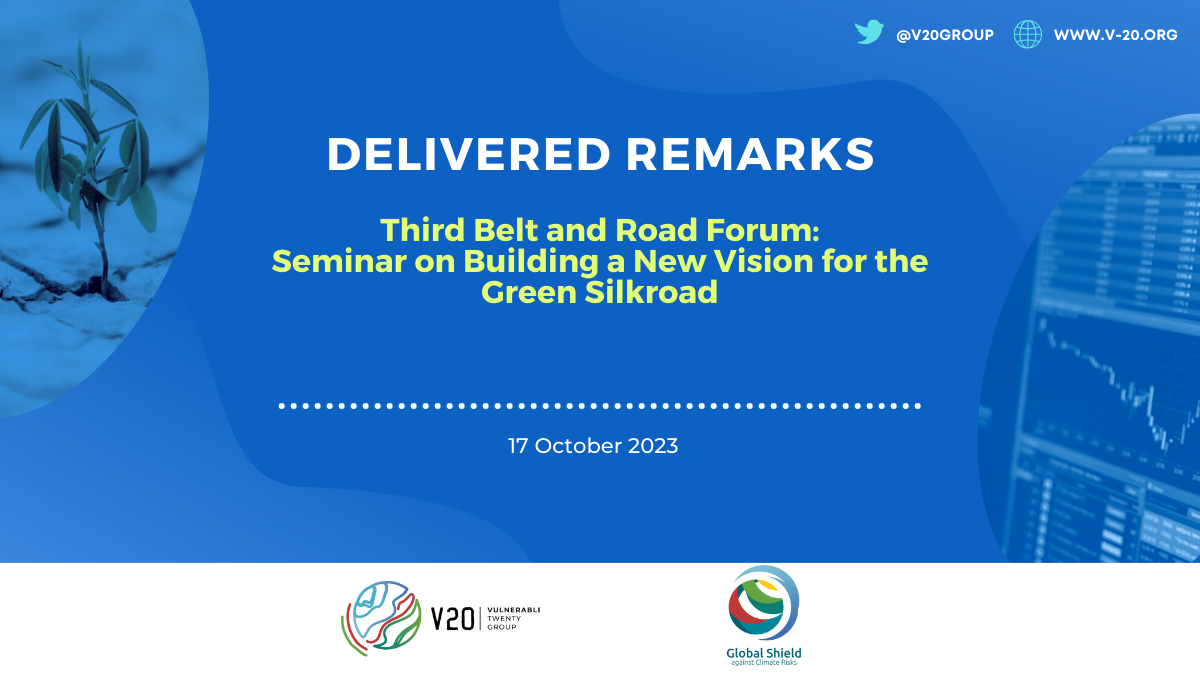Third Belt and Road Forum: Seminar on Building a New Vision for the Green Silkroad

DELIVERED REMARKS
Sara Jane Ahmed, Global Lead and Finance Advisor
CVF and V20 Finance Ministers Secretariat
Third Belt and Road Forum: Seminar on Building a New Vision for the Green Silkroad
17 October 2023, Beijing Hotel, Beijing Palace
Thank you for inviting us to this tremendously important event. The BRI was proposed by China, but it belongs to the whole world. We would like to think that we are all here, ten years later, because we all feel just as responsible for ensuring the BRI reflects our common but differentiated aspirations.
The V20 Finance Ministers is comprised of 68 countries representing 1.74 billion people and USD 3.8 trillion in GDP. It is not merely vulnerability that defines them. What defines V20 is a high sense of agency and capability to do more than survive the climate crisis. The goal is to realize prosperity despite the dire challenges posed by a dangerously warming world.
The success of BRI will also mean our success. The more the BRI turns green, the faster BRI can bring about national prosperity among V20 countries, particularly social harmony, and regional stability realized by renewable energy-propelled cooperation and diplomacy.
The V20 was established in October 2015, two months before the Paris Agreement was gaveled, in order to translate political outcomes into actual investments in the real economy. The purpose then is the same aim today – to develop and offer solutions and strategies responsive to our particular needs – and at the same time reach out to partners like China.
South-South cooperation with dedicated green investments and financing together with deal teams for green project origination can also be exchanged or leveraged for carbon financing, promoting global ambition by delivering domestically.
A lot of our work is driven by a program called Climate Prosperity Plans or CPPs. CPPs are country-led strategic investment plans that establish socio-economic outcomes as a top priority – and integrate climate-resilient and low-carbon results as intrinsic co-benefits. Based on a set of government-endorsed targets and catalytic projects identified, CPPs present a macroeconomic scenario for prosperity, showing how particular prosperity outcomes through to 2030 and by 2050 can be realized. This can further accelerate NDCs.
The first phase of Climate Prosperity Plans was launched in 2021, with the Mujib Climate Prosperity Plan in Bangladesh canceling 10 gigawatts (GW) of coal towards new opportunities for resilient renewable energy security such as offshore wind with a greenbelt of mangroves to support fisherfolk. Currently, an ever-growing number of countries have lined up eagerly to implement their own CPPs, and we know many seek the benefit of working closely with China so they can realize their objectives faster.
Nothing will be easy, of course. V20 countries face limited fiscal space and growing costs due to climate change impacts, despite our minimal emissions. Because of climate change, 55 V20 economies have already lost up to USD 525 billion over the last 20 years. Managing economic transformation and completing the energy transition by ourselves is not only unfair, but also difficult because of this situation.
A successful Green BRI can support: social protection and livelihood opportunities, phase down and out of fossil fuels with low cost and long-term capital, legacy liabilities strategies, grid modernization to give assurances to investors and operators, and finally, to participate in transition and critical minerals opportunities, especially recycling options.
Given this, we continue to be lifted by a high sense of hope, and a sense of trust. In order to work more closely with China to achieve this mutually shared vision sooner, just a few days ago, in Marrakech, V20 ministers agreed to establish a presence in Beijing so that we can roll up our sleeves together and together build this “community with a shared future for mankind.”
Mutual prosperity can only be achieved through shared leadership. We hope China and the V20 can take advantage of the opportunity to design development strategies together, one that delivers high-quality standards for design and construction because it is based on high-quality goals.
The more we can do this together, the sooner we can both play a mutually empowering role in building “a global community of shared future, with the goal of creating an open, inclusive, clean and beautiful world that enjoys lasting peace, universal security and common prosperity, charting a bright future for human development,” as stated in the recently published BRI White Paper.
Countries will gather again soon at COP28 to develop a more ambitious roadmap for climate action. There is no space and time for division. Where cynical observers expect acrimonious blame games in Dubai, China and V20 countries can work together more closely and through a Green BRI. We can and must take advantage of the opportunity to show the world what real cooperation driven by mutual respect actually looks like. And in response to critics who seek to absurdly isolate China, we say V20 and China can and must do more together – and sooner.
###
Reference Documents:
V20 Ministerial Dialogue XI Communique
Credit Kevin Gallagher, Task Force on Climate, Development and the IMF

